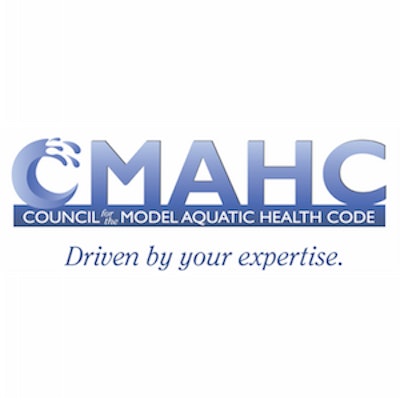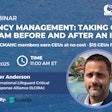
In 2016, the Council for the Model Aquatic Health Code formed an ad hoc committee to define the impact of cyanuric acid on disinfection. The committee members include representatives of stabilized and unstabilized sanitizers and have a diverse range of expertise. The CMAHC Cyanurate Ad Hoc Committee has recently published its work in the journal titled Water. The article is highly technical. The following summary is being provided in terms most pool industry professionals can understand.
The bottom line is this:
CYA decreases the concentration of active sanitizer in the water and so increases the risk of disease transmission. The committee recommends that the current Model Aquatic Health Code ratio of cyanuric acid: free chlorine be reduced from 45:1 to 20:1.
Here are a few more details.
For decades, pool care training programs have taught that pH must be controlled to ensure that sufficient hypochlorous acid, the active sanitizer in pools and spas, is maintained. However, pool care training programs have not usually focused on the effect that CYA has on HOCl concentrations. The following graph shows how HOCl decreases with increasing CYA.
As seen in the graph, the amount of CYA in the water has a dramatic effect on the HOCl concentrations. Many state codes allow up to 100 ppm CYA. This means that at 1 ppm FC, HOCl concentrations can range from 0.47 ppm HOCl (0 ppm CYA) to 0.0067 ppm HOCl (100 ppm CYA) (pH 7.5, 85 °F). In other words, there is about 70 times more active sanitizer at 0 ppm CYA than at 100 ppm CYA. Even with a CYA concentration as low as 10 ppm, the HOCl concentration from 1 ppm FC is reduced to less than 0.066 ppm (pH 7.5, 85 °F).
Unfortunately, there is no pool-side test for HOCl, so there is no way for pool operators to directly measure the concentration of active sanitizer in the water. The HOCl concentration can be calculated using a complex series of equations, but pool operators need a way to control their sanitizer levels without having to pull out a computer every time they run an analysis. Luckily, when the CYA:FC ratio is kept constant, the HOCl concentration is kept constant, so operators would only need to measure CYA and FC to determine if sufficient sanitizer is present.
The following table shows the HOCl concentration with various levels of CYA and FC (pH 7.5, 77 °F):
With a CYA:FC ratio of 20:1, the concentration of HOCl stays pretty constant at 0.02 ppm.
Using calculations from the model published by the ad hoc committee, the risk of getting ill from E. coli O157:H7, a potentially deadly form of E. coli, is about 1 in 2,200 people if there is no FC in the water. With just 1 ppm FC and no CYA, the risk shows a tremendous drop down to 1 in 87,000,000,000,000 people. To put this into perspective, consider that the Centers for Disease Control and Prevention estimated that in 2009 there were approximately 301 million swimming visits each year by persons over the age of six. So if there is always 1 ppm FC with no CYA, there would be an E. coli illness about once every 290,000 years. These values point to the absolute importance of maintaining a FC residual in the pool.
With 100 ppm CYA and 1 ppm FC, the risk of E. coli infection is increased to about 1 in 41,000 people, indicating there may be the potential for multiple infections in a year. The authors of the model caution that because there is so much variability in the data going into the model, the model cannot provide an accurate estimate of absolute risk, however it is believed to provide meaningful estimates of relative risk. So what does this mean? It means that we can’t really say that 1 in 41,000 people would actually get ill from E. coli each year with 1 ppm FC and 100 ppm CYA. But we can say that people are much more likely to get ill from E. coli with 1 ppm FC and 100 ppm CYA than they are with 1 ppm FC with no CYA.
Following is a table showing the relative risks of illness from Giardia:

The table shows that people are 357 times more likely to get ill from Giardia if no chlorine is present, compared to 1 ppm FC. If 10 ppm CYA is used with 1 ppm FC, people are three times as likely to get ill from Giardia, and if 100 ppm CYA is used, people are about 17 times more likely to get ill. With 100 ppm CYA, 49 ppm FC would be needed to reduce the risk of Giardia to approximately the same as 1 ppm FC with no CYA.
Following is a table showing the relative risks of illness from cryptosporidium:

The table shows that people are 5 times more likely to get ill from crypto if no chlorine is present, compared to 1 ppm FC. If 100 ppm CYA is used with 1 ppm FC, people are also 5 times as likely to get ill from crypto.
The MAHC currently recommends a minimum of 2 ppm FC when CYA is present, and limits the CYA maximum to 90 ppm. This results in a CYA:FC ratio of 90:2 or 45:1. By reducing this ratio to 20:1, the committee estimates that the risk of becoming ill from Giardia should be cut in half, and swimmers should be 5 times less likely to become ill from E. coli O157:H7. Further reductions in infection risk could certainly be obtained with lower ratios, but the committee states that a maximum CYA:FC ratio of 20 “is recommended as a compromise between the various suggested values and provides a modest reduction in infection risk from the currently allowed value of 45 without imposing major changes in pool operations.”
To illustrate the potential effect of this change on public health the values in Table 7 of the paper are shown three different ways below:
-
Probability of infection as described in the paper, per-visit risk (Πv)
-
1 illness in x number of swimmers ( x = 1/ Πv)
-
Potential number of illnesses per year based on the estimated value of 301 million swimmer visits per year (illnesses per year = 301,000,000/x)

Operating using a ratio will be a little different. Because CYA levels change relatively slowly and FC levels can change within seconds of a large swim class entering the water, operators can still use their traditional ORP controllers for maintaining FC residuals. However, with a ratio, operators will need to keep the following in mind.
The Environmental Protection Agency regulates all chlorine sanitizers, and does not allow FC concentrations outside the range of 1-4 ppm for pools when swimmers are present. That means that if a pool operator starts the day with 4 ppm FC and the concentration decreases to 1 ppm when a swim class enters, then the maximum CYA concentration the operator can use is 20 ppm CYA. If the operator is able to maintain the FC concentration within a tighter range of 2-4 ppm, then the maximum CYA concentration would be 40 ppm to ensure that the 20:1 CYA:FC ratio is never exceeded. In the unlikely event that the operator is able to maintain 4 ppm FC with absolutely no variation, then a CYA concentration of 80 ppm would be acceptable. The following table summarizes how closely the FC would need to be controlled with a maximum CYA:FC ratio of 20:1.

Operating a pool with unstabilized sanitizers such as sodium hypochlorite or calcium hypochlorite will hardly be any different operating off of a ratio. Cyanuric acid can be added to the pool at concentrations up to 20 ppm, and the pool can operate as usual, with the FC concentration allowed to vary between 1 and 4 ppm. If stabilized sanitizers are used, operation will be more difficult. Operators will need to keep a very close eye on the CYA concentration. As the CYA concentration climbs, the minimum acceptable FC level will also climb. To avoid increasing the risk of swimmer illness, operators must ensure that they meet this moving target, without exceeding the federally regulated 4 ppm maximum limit for FC in pools. Their flexibility will decrease as CYA concentrations increase. Once they can no longer maintain FC levels within the required range, they will need to drain the pool to decrease the CYA concentration. Information on drainage frequency and cost may be found in this technical bulletin.
If operating off of a ratio sounds too complicated, you can operate using absolute limits for FC and CYA that are consistent with the 20:1 ratio concept. The current MAHC limits are a minimum of 2 ppm FC in the presence of CYA, and an absolute limit of 90 ppm CYA. This is essentially a CYA:FC ratio of 90:2 or 45:1. If the ratio is reduced to 20:1, and there is a minimum of 2 ppm FC, the maximum CYA would be 2 x 20 = 40 ppm.
So what should you do to help prevent recreational water illnesses?
First and foremost, minimize contamination of the pool:
-
Prevent swimmers from peeing or pooping in the pool since the sources of many recreational water illnesses (E. coli, giardia, cryptosporidium) are from the people in the pool.
-
Promote showering before entering the water so that any germs adhering to swimmers can get rinsed down the drain instead of into the pool.
Second, optimize the sanitization of your pool water:
-
Maintain a residual sanitizer in all parts of the pool at all times
-
Maximize the efficacy of your sanitizer by using the least amount of CYA stabilizer that you need to maintain a residual. A good practice is to maintain CYA at 20 ppm or less and FC from 1 to 4 ppm.










































